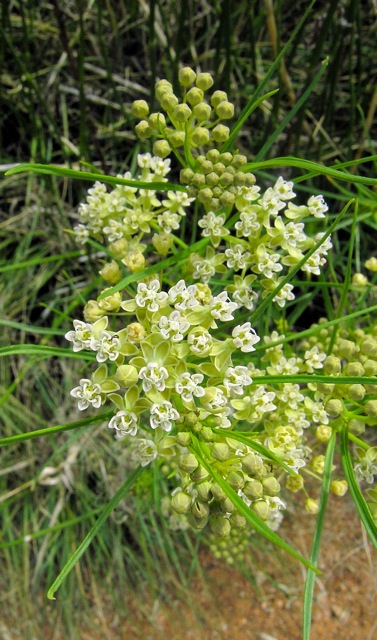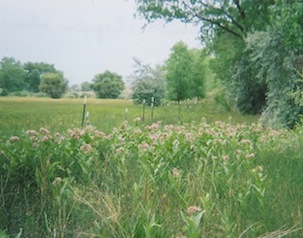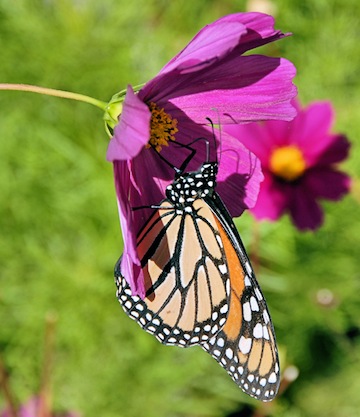Article by Janice Tucker

Poison milkweed Asclepias subverticillata by Janice Tucker
November 6, 2018
updated from original publish date of February 1, 2014
Since the early 1990s observers have noticed that each year fewer monarchs are making their winter migration from Canada to Mexico and summer return trip from Mexico back to Canada. It soon became clear that the disappearance of the milkweed plant habitats – a vital part of the monarchs’ existence – was the major cause of the decline in the monarch butterfly population. “Bring Back the Monarchs” established by Monarch Watch in 1992 began the movement to reverse this trend. Their excellent website – www.monarchwatch.org – contains a wealth of information on this nature crisis, and includes helpful suggestions on how everyone can help.
The milkweed is one of many nectar plants for this butterfly but is the only larvae host plant used by the monarchs. Without a plant for the monarchs to lay their eggs so that the caterpillars can metamorphose into adults, the species will die out. Unfortunately, the milkweed is in danger of losing large habitats that are in the path of the monarchs’ semi-annual migrations.
The main causes for the loss of the milkweed habitats are: Increased commercial and residential developments, roadside construction and most importantly, the use of herbicides that are now being applied to kill plants within the crop area without harming the crop itself. Because milkweed is considered a weed that does little or no good, there is lack of concern. This attitude is wrong, of course. The milkweed has medicinal benefits and also provides nectar for a large number of pollinators, as well as both a larva host plant and nectar plant for the monarch butterfly. Please read more about the milkweed in the accompanying article.
February 2014 Plant of the Month: Asclepias
Individuals can help by planting butterfly gardens that include milkweed, especially native species to their area. Helping the monarch butterfly will also help other species of pollinators. See a list of suggested plants following this article. Another good website for finding plants – nectar and host plants – that attract many butterfly species is The Butterfly Website http://butterflywebsite.com/butterflygardening.cfm.
Butterflies! How can you not love them? We want to attract them to our gardens and see them in our parks and public areas. We need to save these pollinators. We want them here forever. Let’s help bring back the monarchs. Please visit Monarch Watch at www.monarchwatch.org and get involved.

Showy Milkweed by Helen Woody
The following is a limited list of plants that should grow well in Santa Fe’s USDA plant zone (6b). It is focused on plants that attract monarch butterflies, but gardeners can certainly add other plants that attract different species of butterflies.
Milkweed species: (Host plants for the Monarch butterfly larvae and nectar plants for the Monarch as well as other butterflies, birds, bees and other insects): For host plants to other butterfly species, visit: http://butterflywebsite.com/butterflygardening.cfm.
Butterfly weed (Asclepias tuberosa) – orange to yellow flowers
Swamp milkweed (Asclepias incarnata) – pink/lavender flowers
Showy milkweed (Asclepias speciosa) – rosy pink flowers
*Spider milkweed (Asclepias asperula) – greenish-white flowers
*Poison milkweed (Asclepias subverticillata) – white flowers
*Broadleaf milkweed (Asclepias latifolia) – white flowers
NOTE: Some lists recommend the common milkweed (Asclepias syriaca) but it can spread rather aggressively. Pretty, brilliant, pink flower but rough looking plant.
*These milkweeds grow naturally. It may be difficult to find seeds commercially and the best seeds are through trusted monarch support sites or trusted local nurseries as some large commercial nurseries spay seeds with chemicals. Transplanting from their natural habitat is frowned upon and some do not transplant well.
Nectar plants:
Blue sage (Salvia farinacea) – blue, lavender or purple flowers
Chia (Salvia columbariae) – deep to light purple flowers
Scarlet sage (Salvia coccinea) – bright to light red flowers
Russian sage (Perovskoa atriplicifolia) – blue flowers
Blue mist spirea (Caryopteris spp.) – blue flowers
Mexican sunflower ‘Torch’- (Tihthonia ‘Torch’) – yellow, gold, red-orange flowers
Zinnia, Dahlia mix (Zinnia spp. & Dahlia spp.) – variety of flower colors
Chives (Allium schoenoprasum) – purple flowers
Indian blanket (Gaillardia spp.) – yellow or gold, flowers with reddish centers
Black-eyed Susan (Rudbeckia spp) – yellow flowers, chocolate centers
Mexican hat (Ratibida columunifera) – yellow, deep red, gold flowers
Jupiter’s beard (Centranthus ruber) – red flowers
Cone flower (Echinacea) – variety of flower colors – yellow, lavender and pink
Cosmos (Cosmos spp) – variety of flower colors – deep pink, lavender, white, yellow, red
Butterfly bush – (Buddleia spp.) – Variety of flower colors – white, purples, yellow
Yarrow (Achillea spp.) – variety of flower colors – red, pink, salmon, yellow, and white
Variety of Asters.

Monarch Butterfly on Cosmos by Sonny Tucker


